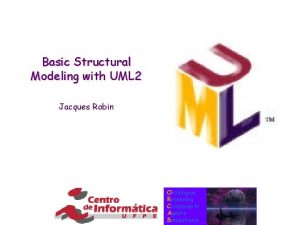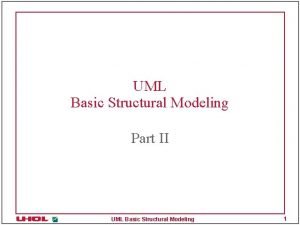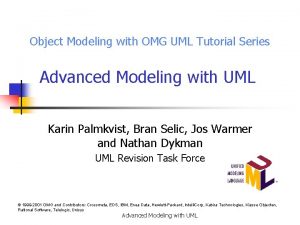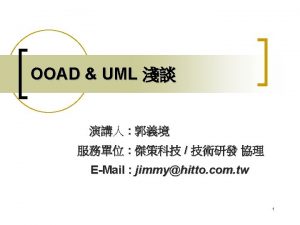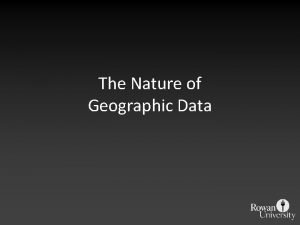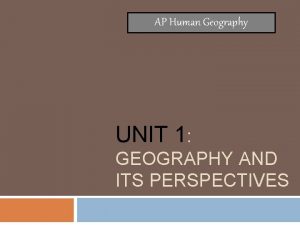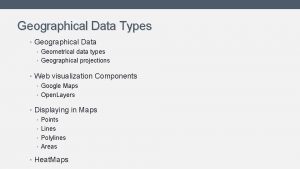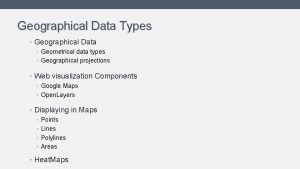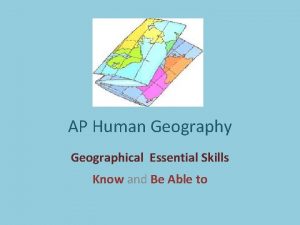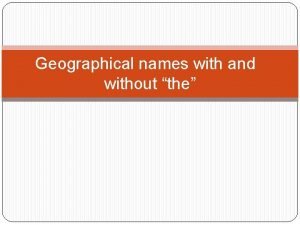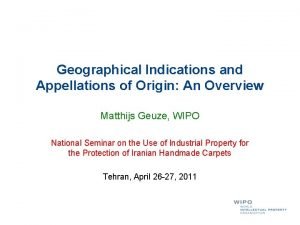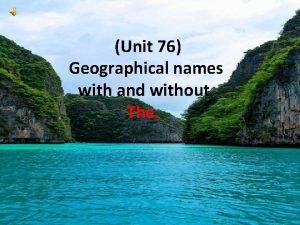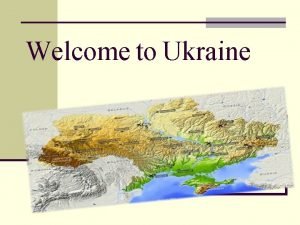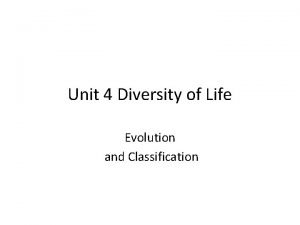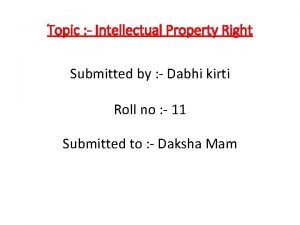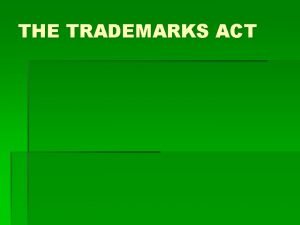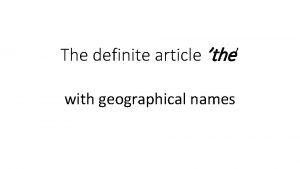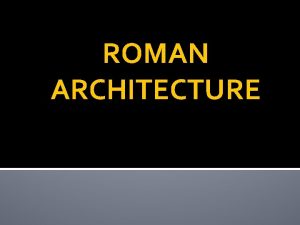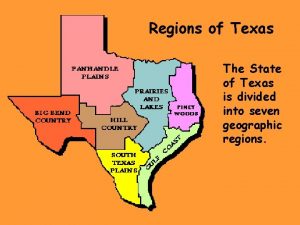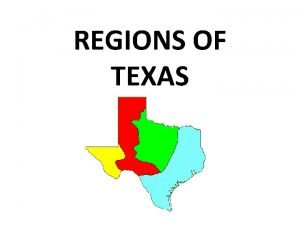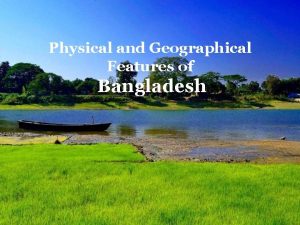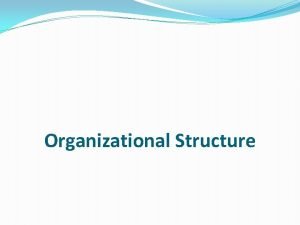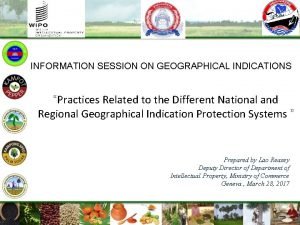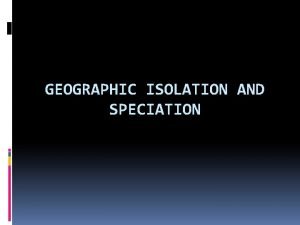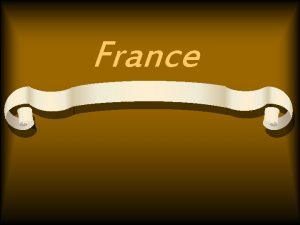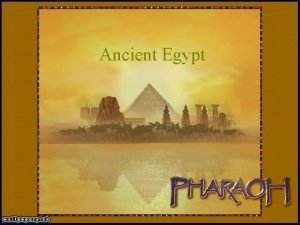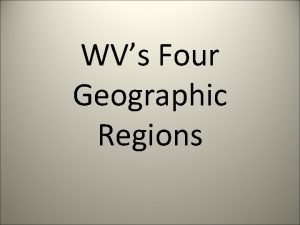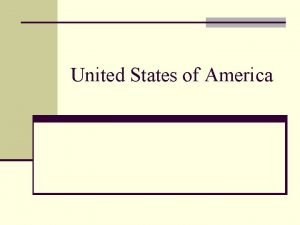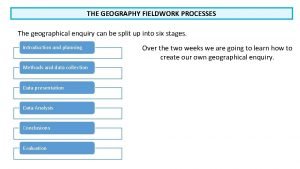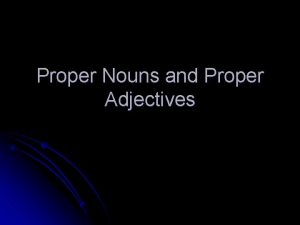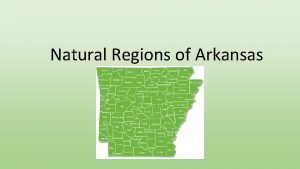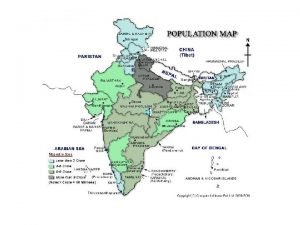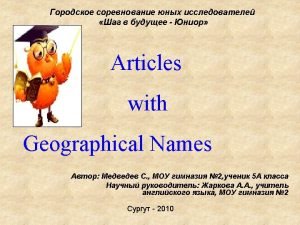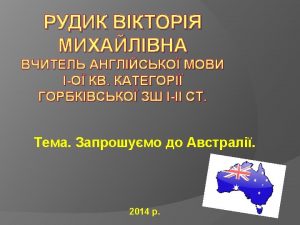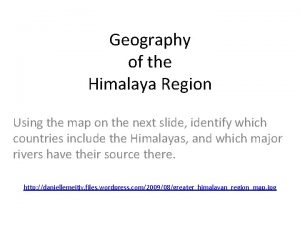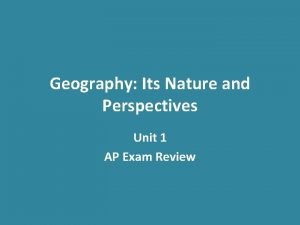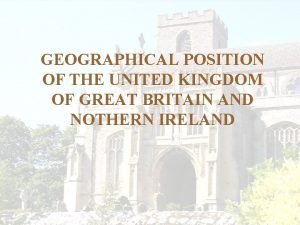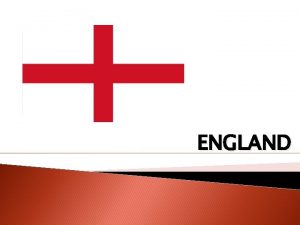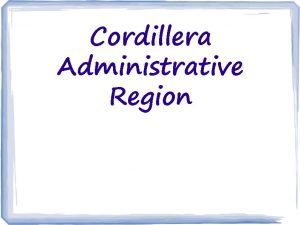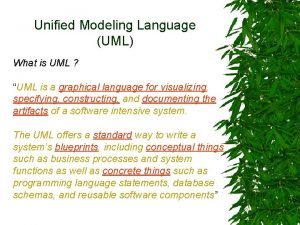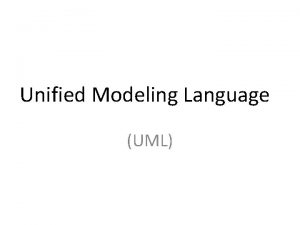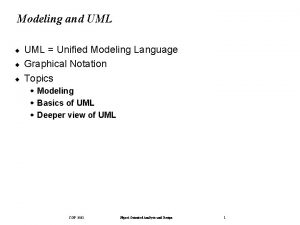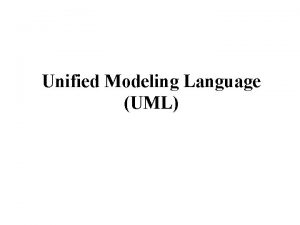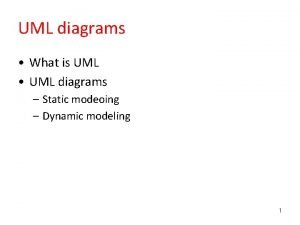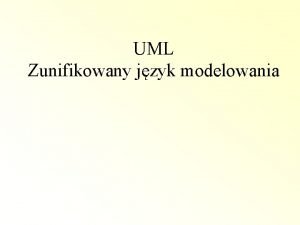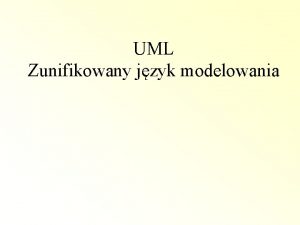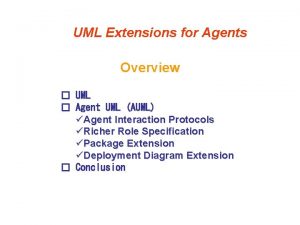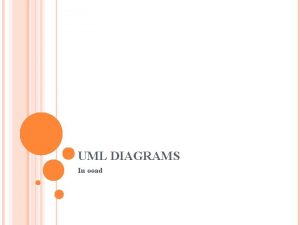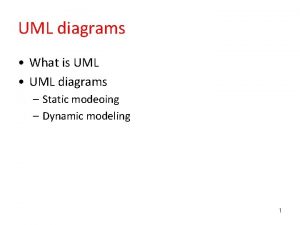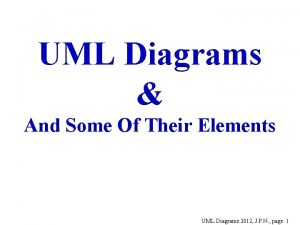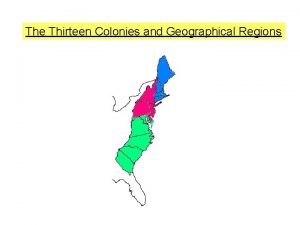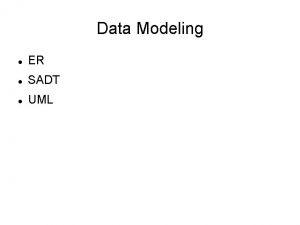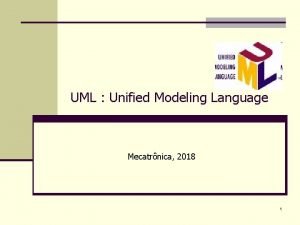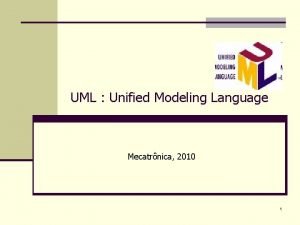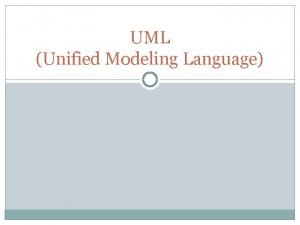Geographical Data Modeling UML and Data Modeling Elements















































- Slides: 47

Geographical Data Modeling UML and Data Modeling Elements Examples from the Marine Data Model and Arc. Hydro (Thanks to Dawn Wright) Longley et al. , ch. 8

Models for GIS representation of reality --> model GIS itself is based on a model of complexity and used to model complexity Not a full representation of reality: even at 1: 1 data model = limited representation of reality l l a discretization or partitioning of space finite, discrete nature of computing devices

Data Model Representation of information about a form or a process E. g. a weather map with isotherms FIELD … “grid” OBJECT … “isoline” A good model allows us to infer process FIELD or OBJECT … “geo-relational”

3 Data Models geo-relational coverage (object view; from classic Arc. Info polys) geo-relational shapefile (object view; from Arc. View) geodatabase (object-oriented; new in Arc. GIS 8, 9 etc. )

Object Oriented GIS (p. 191) Object: a self-contained package of information describing an entity Collection of objects – class Objects can have behavior – encapsulation Inheritance – reusable objects Polymorphism-objects can have their own implementation for application-e. g. create, draw, delete

Georelational Data Model: “Classic” Arc. Info and Arc. View command line interface Unix, NT, Windows Arc. View as interface A B

Arc. Info Coverage as a Data Structure Image courtesy of Louisville/Jefferson County Information Consortium, Kentucky

Data Structure Not tied to process at all Concerned simply with what can be computed and what can’t Way in which the data model is represented in the GIS DEM for grid or layer model (e. g. array) l contour for isoline model l TIN for Delaunay triangulation model l coverages, shapefiles for geo-relational l geodatabase for OO geodatabase l

Arc. GIS 9 Icons yellow coverage green shapefile gray geodatabase

Geodatabase Features and attributes as objects Relationships among features encoded Validation or editing rules, behaviors “Container” for l l l MS-Office Vector, raster, tabular data Relationships Topology

Relationships for a feature

Arc. GIS Data Models support. esri. com/datamodels. cfm

Arc. Marine dusk. geo. orst. edu/djl/arcgis

Data Modeling for Spatial Analysis What is spatial analysis? l "a set of methods whose results change when the locations of the objects being analyzed change" Methods for working with spatial data l l l to detect patterns, anomalies to find answers to questions to test or confirm theories l l deductive reasoning-general to specific to generate new theories and generalizations l inductive reasoning-specific to general

What is Spatial Analysis (cont. ) Methods for adding value to data in doing scientific research l in trying to convince others l A collaboration between human and machine How do we set up the framework for spatial analysis? l Data model to data structure

A Georelational to a Geodatabase Model Coverage and shapefile data structures l homogenous collections of points, lines, and polygons with generic, 1 - and 2 -dimensional "behavior" as operations Can’t distinguish behaviors l Point for a marker buoy, same as point for observation “smart features” in a geodatabase l lighthouse must be on land, marine mammal siting must be in ocean l Objects can “self-police”

Purpose of Arc. Hydro, Arc. Marine etc. Basic template for implementing GIS projects l input, formatting, geoprocessing, creating maps, performing analyses Basic framework for writing program code and maintaining applications l development of tools for the community Promote networking and data sharing through established standards l common model=interoperability

“Generic” Marine Data Model User Group Data Model Project Data Model User Group Data Model Inheritance Arc. Marine Design Strategy Project Data Model

Geodatabase Concepts ESRI's data object-oriented data model l objects, features, behaviors Geodatabase l l collection of feature data sets, rasters, TINs all data in relational tables behavior is coupled with features through rules (object-orientation) Supports model-builder for processes Feature data set l l l contains feature classes defines topological role of features has a coordinate system

Geodatabase Concepts ( cont. ) Feature class stored in a relational table l special field for geometric shape l geometric data incorporated into the database l l Point, multipoint, segment, path, ring, polyline, polygon

Geodatabase Feature Class Geometries

Modeling Process Conceptual Model Lists, flow diagrams, etc Real World Objects and relationships Logical Model Diagram in CASE Tool Physical Model Database Schema (Object state) Graphic courtesy of ESRI

Data Model Levels Humanoriented Reality Conceptual Model Logical Model Computeroriented Physical Model Increasing Abstraction

Specific Steps in Data Modeling (1) Conceptualize the user's view of data l what are the basic features needed to solve the problem? (2) Select the geographic representation l points, lines, areas, rasters, TINs (3) Define objects, features, and relationships l draw a UML diagram, specify relationships, “behaviors” (4) Match to geodatabase elements l Refine relationships, “behaviors” (5) Organize geodatabase structure, add data

( 1 ) User’s View of Data

( 1 ) User’s View of Data cont.


(2) Select geographic rep.


Steps in Data Modeling (1) Conceptualize the user's view of data l what are the basic features needed to solve the problem? (2) Select the geographic representation l points, lines, areas, rasters, TINs (3) Define objects and relationships l draw a UML diagram, specify relationships, “behaviors” (4) Match to geodatabase elements l Refine relationships, “behaviors” (5) Organize geodatabase structure, add data

Unified Modeling Language Entity-relationship diagrams Design the methodologies, diagram notations UML Not a design methodology l Just a diagrammatic notation based on methods l Endorsed by leading software and database companies l

UML ( cont. ) Diagrammatic notation = “visual language”. . . For constructing a data model Drawings, relationships constructed in Visio (other tools available) Tools to input a drawing into Arc. GIS l input drawing to the data model

UML Notation a class is shown as a box top part contains the name of the class lower part contains the attributes methods associated with the class lines connect boxes and indicate relationships

Graphic courtesy of Maidment et al. , Arc. Hydro team

UML Notation ( cont. ) Abstract class l l l specify subclasses underneath Mammals w/human or dog feature classes no new instances Feature Class l l Specify subtypes underneath Human, dog, cat

Objects and Features Object (real world) l l l in Arc. GIS an object is non-spatial it is NOT a point, line, or area it has no geographic location it has no shape attribute in its table Drainage network, ship, vehicle, … customer, lake, house, etc. Feature (spatial context) l l an object that has geographic location a point, line, area, TIN, raster

Relationships Links between classes, shown as lines One to one One to many Many to many

Relationships (cont. ) 1: 1 - solid line l one record in Class A linked to one record in Class B l l “is married to” the class of state capitals linked to the class of states 1: n - solid line with * at one end l one record in Class A linked to any number of records in Class B l l "owns" the class of states linked to the class of area codes

Relationships (cont. ) m: n - solid line with * at both ends l any number of records in Class A linked to any number of records in Class B "has visited” l "was never married to" l the class of mountain lions linked to the class of wilderness areas l


Graphic courtesy of Maidment et al. , Arc. Hydro team

Type Inheritance White triangle Class B inherits the properties (attributes, methods) of Class A the class street inherits from the class transportation network Solid diamond the parts and the whole depend on each other

Graphic courtesy of Maidment et al. , Arc. Hydro team


Steps in Data Modeling (1) Conceptualize the user's view of data l what are the basic features needed to solve the problem? (2) Select the geographic representation l points, lines, areas, rasters, TINs (3) Define objects and relationships l draw a UML diagram, specify relationships, “behaviors” (4) Match to geodatabase elements l Refine relationships, “behaviors” (5) Organize geodatabase structure, add data


Steps in Data Modeling (1) Conceptualize the user's view of data l what are the basic features needed to solve the problem? (2) Select the geographic representation l points, lines, areas, rasters, TINs (3) Define objects and relationships l draw a UML diagram, specify relationships, “behaviors” (4) Match to geodatabase elements l Refine relationships, “behaviors” (5) Organize geodatabase structure, add data l e. g. , Marine Data Model tutorial
 Mda uml
Mda uml Helen erickson biography
Helen erickson biography Superstruture
Superstruture Basic structural modeling in uml
Basic structural modeling in uml Uml modeling tutorial
Uml modeling tutorial Use case outline
Use case outline Nature of geographical data
Nature of geographical data Thematic map ap human geography
Thematic map ap human geography Types of geographical data
Types of geographical data Geometrical data
Geometrical data Essential skills to study geography
Essential skills to study geography Dimensional modeling vs relational modeling
Dimensional modeling vs relational modeling Continents without names
Continents without names Geographical indication and appellation of origin
Geographical indication and appellation of origin Geographical names with and without the
Geographical names with and without the Data warehouse design best practices
Data warehouse design best practices Geographical position of ukraine
Geographical position of ukraine Binomial nomenclature
Binomial nomenclature Registration process of geographical indication
Registration process of geographical indication Registration of geographical indication
Registration of geographical indication Geographical features of the southeast region
Geographical features of the southeast region The with geographical names
The with geographical names Geographical influence of roman architecture
Geographical influence of roman architecture Geographical regions of texas
Geographical regions of texas Geographical regions of texas
Geographical regions of texas Geographical features of bangladesh
Geographical features of bangladesh Geographical divisional structure
Geographical divisional structure Stage 4 geography syllabus
Stage 4 geography syllabus Registration process of geographical indication
Registration process of geographical indication Geographic isolation
Geographic isolation France court system
France court system 8
8 Geographical map of ancient egypt
Geographical map of ancient egypt Potomac section wv
Potomac section wv Geographical position usa
Geographical position usa 6 stages of geography fieldwork
6 stages of geography fieldwork Geographical nouns
Geographical nouns 6 regions of arkansas
6 regions of arkansas Geographical position has given india
Geographical position has given india Test articles with geographical names
Test articles with geographical names Australia geographical position
Australia geographical position Sahrd
Sahrd Geographical map of himalayas
Geographical map of himalayas What geographical feature usually distinguishes time zones?
What geographical feature usually distinguishes time zones? Great britain geographical position
Great britain geographical position What is a geographical event
What is a geographical event England geographical position
England geographical position Geographical location of hudhud
Geographical location of hudhud


